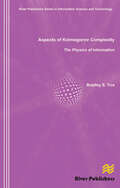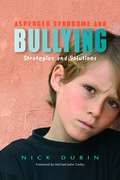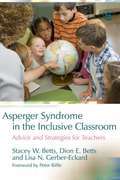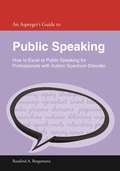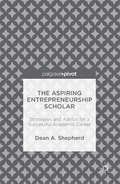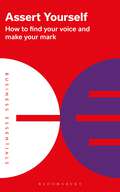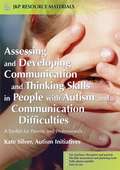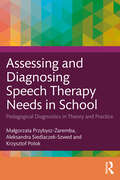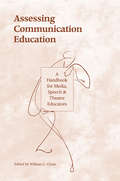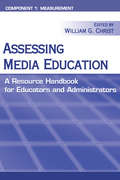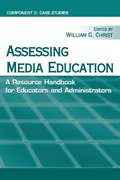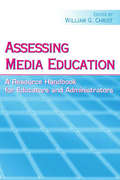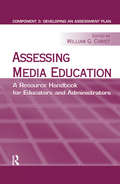- Table View
- List View
Aspects of Kolmogorov Complexity the Physics of Information (River Publishers Series In Information Science And Technology Ser.)
by Bradley S. TiceThe research presented in Aspects of Kolmogorov Complexity addresses the fundamental standard of defining randomness as measured by a Martin-Lof level of randomness as found in random sequential binary strings. A classical study of statistics that addresses both a fundamental standard of statistics as well as an applied measure for statistical communication theory. The research points to compression levels in a random state that are greater than is found in current literature. A historical overview of the field of Kolmogorov Complexity and Algorithmic Information Theory, a subfield of Information Theory, is given as well as examples using a radix 3, radix 4, and radix 5 base numbers for both random and non-random sequential strings. The text also examines monochromatic and chromatic symbols and both theoretical and applied aspects of data compression as they relate to the transmission and storage of information. The appendix contains papers on the subject given at conferences and the references are current.ContentsTechnical topics addressed in Aspects of Kolmogorov Complexity include:• Statistical Communication Theory• Algorithmic Information Theory• Kolmogorov Complexity• Martin-Lof Randomness• Compression, Transmission and Storage of Information
Aspects of Kolmogorov Complexity the Physics of Information
by Bradley S. TiceThe research presented in Aspects of Kolmogorov Complexity addresses the fundamental standard of defining randomness as measured by a Martin-Lof level of randomness as found in random sequential binary strings. A classical study of statistics that addresses both a fundamental standard of statistics as well as an applied measure for statistical communication theory. The research points to compression levels in a random state that are greater than is found in current literature. A historical overview of the field of Kolmogorov Complexity and Algorithmic Information Theory, a subfield of Information Theory, is given as well as examples using a radix 3, radix 4, and radix 5 base numbers for both random and non-random sequential strings. The text also examines monochromatic and chromatic symbols and both theoretical and applied aspects of data compression as they relate to the transmission and storage of information. The appendix contains papers on the subject given at conferences and the references are current.ContentsTechnical topics addressed in Aspects of Kolmogorov Complexity include:• Statistical Communication Theory• Algorithmic Information Theory• Kolmogorov Complexity• Martin-Lof Randomness• Compression, Transmission and Storage of Information
Asperger Syndrome and Bullying: Strategies and Solutions
by Nick DubinBullying is a serious problem for people with Asperger Syndrome (AS), both at school and in the workplace, and displaying 'different' behavior, such as not understanding social rules or hand-flapping, exacerbates the risk of being victimized. Writing in an accessible, informal style, the author describes the bullying behavior he and other individuals have experienced, and the effect this has had on their lives. He outlines the reasons for bullying behavior and the danger of persistent recurrence if it remains unchecked, as well as the critical importance of 'involving the bystander'. Nick Dubin goes on to provide a range of effective strategies to address bullies and bullying that can be applied by parents, professionals, schools, and individuals being bullied. He stresses the importance of peer intervention, empathetic teachers, and verbal self-defense, and shows how lack of support, condemning of 'tale telling,' or even blaming the victim reinforces bullying. This book offers individuals with AS who are being bullied the opportunity to see that they are not alone, and it is an invaluable source of advice for parents, teachers, professionals and personnel managers.
Asperger Syndrome and Bullying: Strategies and Solutions (PDF)
by Nick DubinBullying is a serious problem for people with Asperger Syndrome (AS), both at school and in the workplace, and displaying 'different' behavior, such as not understanding social rules or hand-flapping, exacerbates the risk of being victimized. Writing in an accessible, informal style, the author describes the bullying behavior he and other individuals have experienced, and the effect this has had on their lives. He outlines the reasons for bullying behavior and the danger of persistent recurrence if it remains unchecked, as well as the critical importance of 'involving the bystander'. Nick Dubin goes on to provide a range of effective strategies to address bullies and bullying that can be applied by parents, professionals, schools, and individuals being bullied. He stresses the importance of peer intervention, empathetic teachers, and verbal self-defense, and shows how lack of support, condemning of 'tale telling,' or even blaming the victim reinforces bullying. This book offers individuals with AS who are being bullied the opportunity to see that they are not alone, and it is an invaluable source of advice for parents, teachers, professionals and personnel managers.
Asperger Syndrome in the Inclusive Classroom: Advice and Strategies for Teachers (PDF)
by Dion Betts Lisa N. Gerber-Eckard Stacey W. BettsAsperger Syndrome in the Inclusive Classroom offers support and practical techniques for teachers who work with children with Asperger Syndrome (AS). Based on the successful experiences of classroom teachers, and written from a teacher's perspective, this book provides creative and easy-to-apply strategies that support and encourage AS students in the mainstream classroom, from organization and time management techniques to framing classroom instructions to make lessons more accessible for children with AS. The authors' straightforward, practical advice relates to every part of the school day and includes advice for teaching specific subject areas. They give tips on helping students navigate the school environment, how to handle social situations like lunch and breaks, and what to do during unstructured periods. This book is essential reading for teachers and school staff who want to fully include AS students in the classroom.
Asperger Syndrome in the Inclusive Classroom: Advice and Strategies for Teachers
by Lisa N. Gerber-Eckard Stacey W. Betts Dion BettsAsperger Syndrome in the Inclusive Classroom offers support and practical techniques for teachers who work with children with Asperger Syndrome (AS). Based on the successful experiences of classroom teachers, and written from a teacher's perspective, this book provides creative and easy-to-apply strategies that support and encourage AS students in the mainstream classroom, from organization and time management techniques to framing classroom instructions to make lessons more accessible for children with AS. The authors' straightforward, practical advice relates to every part of the school day and includes advice for teaching specific subject areas. They give tips on helping students navigate the school environment, how to handle social situations like lunch and breaks, and what to do during unstructured periods. This book is essential reading for teachers and school staff who want to fully include AS students in the classroom.
An Asperger's Guide to Public Speaking: How to Excel at Public Speaking for Professionals with Autism Spectrum Disorder
by Rosalind A. BergemannThis practical guide to effective public speaking for professionals with Asperger Syndrome (Autism Spectrum Disorder) provides tailored advice on using your Asperger strengths to your advantage and overcoming areas of challenge to find your public speaking voice. Written by a business leader with Asperger Syndrome, it includes guidance and hands-on tools for preparation, research and delivery of successful speeches and presentations. It addresses all the key areas that can cause particular difficulty for people with Asperger Syndrome such as coping with anxiety, interpreting the facial expressions of your audience, awareness of your own body language as projected to others, sensory overload issues caused by the speaking environment, and surviving post-speech networking and social events. Whether giving a presentation at a meeting, hosting a corporate event, or delivering an autism awareness speech, this book provides all the guidance that professionals with Asperger Syndrome need to master public speaking.
An Asperger's Guide to Public Speaking: How to Excel at Public Speaking for Professionals with Autism Spectrum Disorder (PDF)
by Rosalind A. BergemannThis practical guide to effective public speaking for professionals with Asperger Syndrome (Autism Spectrum Disorder) provides tailored advice on using your Asperger strengths to your advantage and overcoming areas of challenge to find your public speaking voice. Written by a business leader with Asperger Syndrome, it includes guidance and hands-on tools for preparation, research and delivery of successful speeches and presentations. It addresses all the key areas that can cause particular difficulty for people with Asperger Syndrome such as coping with anxiety, interpreting the facial expressions of your audience, awareness of your own body language as projected to others, sensory overload issues caused by the speaking environment, and surviving post-speech networking and social events. Whether giving a presentation at a meeting, hosting a corporate event, or delivering an autism awareness speech, this book provides all the guidance that professionals with Asperger Syndrome need to master public speaking.
The Aspiring Entrepreneurship Scholar: Strategies and Advice for a Successful Academic Career
by Dean A. ShepherdThis book offers helpful insight and advice on how doctoral students and junior faculty can succeed as an entrepreneurship scholar. It invites them to think entrepreneurially to identify research opportunities, manage the publication process, achieve excellence in the classroom, secure a faculty position, and build a research record worthy of promotion and tenure. Drawing from his experience as a research scholar, editor, review board member, mentor, and reviewer of many promotion and tenure cases, author Dean Shepherd offers strategies and other pieces of advice for navigating the obstacles that can prevent a successful scholarly career.This book provides an overview and roadmap to help entrepreneurship scholars achieve success, and stimulates thought and discussion for doctoral students and junior and senior faculty to consider as they look to develop the next generation in academia.
Assert Yourself: How to find your voice and make your mark (Business Essentials)
by Bloomsbury PublishingThe essential guide to making your voice heard and having your efforts recognised.Do you find it hard to say 'no'? Are you tongue-tied in important meetings? Bored of 'mansplaining' when you know that you're the best qualified person on a particular topic? Understanding the difference between being assertive and being aggressive can be a crucial lesson on your career journey, and Assert Yourself can help you find your voice and stand up for yourself.Full of practical advice on how to change the way you work and live for the better, the book contains a self-assessment quiz, step-by-step guidance, top tips, common mistakes and advice on how to avoid them, and summaries of key points.
Assert Yourself: How to find your voice and make your mark (Business Essentials)
by Bloomsbury PublishingThe essential guide to making your voice heard and having your efforts recognised.Do you find it hard to say 'no'? Are you tongue-tied in important meetings? Bored of 'mansplaining' when you know that you're the best qualified person on a particular topic? Understanding the difference between being assertive and being aggressive can be a crucial lesson on your career journey, and Assert Yourself can help you find your voice and stand up for yourself.Full of practical advice on how to change the way you work and live for the better, the book contains a self-assessment quiz, step-by-step guidance, top tips, common mistakes and advice on how to avoid them, and summaries of key points.
Assessing and Developing Communication and Thinking Skills in People with Autism and Communication Difficulties: A Toolkit for Parents and Professionals
by Paul DobsonThis fully photocopiable resource offers a flexible framework for the assessment and measurement of the communication skills of children with autistic spectrum disorders (ASDs). Packed with practical assessment and planning sheets, it enables teachers, educators and other professionals to observe and record how children use and understand language, and to follow their progress over time. The completed assessment record is an accessible summary of a child's individual communication style, identifying strengths and weaknesses and the ways in which he or she is best assisted and motivated to communicate. It focuses on how children express themselves in everyday situations - for example, how they make requests or gain attention, the words they use most frequently, and how their communication is affected by different people and places. Most importantly, it provides a diagnosis of where communication skills can be developed and improved. Using the communication curriculum, educators can set appropriate targets, linked to work in other areas, such as literacy and science. A separate thinking skills curriculum aims to develop the skills and confidence necessary for social interaction, from making simple choices to understanding humour and abstract ideas. Originally devised for use with children with ASDs, this toolkit is equally effective in identifying communication problems in other children, and is an invaluable resource for teachers and speech and language therapists.
Assessing and Developing Communication and Thinking Skills in People with Autism and Communication Difficulties: A Toolkit for Parents and Professionals (PDF)
by Kate Silver Paul DobsonThis fully photocopiable resource offers a flexible framework for the assessment and measurement of the communication skills of children with autistic spectrum disorders (ASDs). Packed with practical assessment and planning sheets, it enables teachers, educators and other professionals to observe and record how children use and understand language, and to follow their progress over time. The completed assessment record is an accessible summary of a child's individual communication style, identifying strengths and weaknesses and the ways in which he or she is best assisted and motivated to communicate. It focuses on how children express themselves in everyday situations - for example, how they make requests or gain attention, the words they use most frequently, and how their communication is affected by different people and places. Most importantly, it provides a diagnosis of where communication skills can be developed and improved. Using the communication curriculum, educators can set appropriate targets, linked to work in other areas, such as literacy and science. A separate thinking skills curriculum aims to develop the skills and confidence necessary for social interaction, from making simple choices to understanding humour and abstract ideas. Originally devised for use with children with ASDs, this toolkit is equally effective in identifying communication problems in other children, and is an invaluable resource for teachers and speech and language therapists.
Assessing and Diagnosing Speech Therapy Needs in School: Pedagogical Diagnostics in Theory and Practice
by Małgorzata Przybysz-Zaremba Aleksandra Siedlaczek-Szwed Krzysztof PolokAssessing and Diagnosing Speech Therapy Needs in School is a unique text that offers practical guidance in pedagogical diagnosis of speech and communication difficulties within educational settings It outlines theoretical assumptions of the diagnosis process and presents hands-on solutions for pedagogical and speech therapy. Underpinned by theoretical knowledge and written by experienced practitioners, the book equips its readers with tools to understand the diagnostic process and make accurate diagnoses based on each child’s individual circumstances. It starts by clearly distinguishing between pedagogy and speech therapy and outlines issues and theoretical considerations in diagnosing these disorders. To contextualize the theorical observations, it goes on to present case studies, and touches upon crucial topics including readiness to start education, tendency toward aggressive behavior, aphasia and hearing loss. The authors also elaborate on a range of selected diagnostic tools to assess specific difficulties in speech and language therapy. Finally, a list of resources, including games and exercises that can target reading, writing and articulation skills to help children develop, are also featured in the book. Highlighting the importance of practical and theoretical knowledge for those who work with children, this will be a valuable aid for teachers, special educators and speech and language therapists working within school settings. The book will also be of interest to students, teachers and trainee practitioners in the fields of speech therapy and special educational needs.
Assessing and Diagnosing Speech Therapy Needs in School: Pedagogical Diagnostics in Theory and Practice
by Małgorzata Przybysz-Zaremba Aleksandra Siedlaczek-Szwed Krzysztof PolokAssessing and Diagnosing Speech Therapy Needs in School is a unique text that offers practical guidance in pedagogical diagnosis of speech and communication difficulties within educational settings It outlines theoretical assumptions of the diagnosis process and presents hands-on solutions for pedagogical and speech therapy. Underpinned by theoretical knowledge and written by experienced practitioners, the book equips its readers with tools to understand the diagnostic process and make accurate diagnoses based on each child’s individual circumstances. It starts by clearly distinguishing between pedagogy and speech therapy and outlines issues and theoretical considerations in diagnosing these disorders. To contextualize the theorical observations, it goes on to present case studies, and touches upon crucial topics including readiness to start education, tendency toward aggressive behavior, aphasia and hearing loss. The authors also elaborate on a range of selected diagnostic tools to assess specific difficulties in speech and language therapy. Finally, a list of resources, including games and exercises that can target reading, writing and articulation skills to help children develop, are also featured in the book. Highlighting the importance of practical and theoretical knowledge for those who work with children, this will be a valuable aid for teachers, special educators and speech and language therapists working within school settings. The book will also be of interest to students, teachers and trainee practitioners in the fields of speech therapy and special educational needs.
Assessing Communication Education: A Handbook for Media, Speech, and Theatre Educators (Routledge Communication Series)
by William G. ChristDesigned as a handbook, this text provides media, speech (public speaking, interpersonal, small group, and organizational communication), and theatre educators with both the theoretical and practical ammunition to fight the assessment battles on their campuses. The philosophical implications of accountability are balanced with concrete, specific, and usable assessment strategies. Stressing student, faculty, course, program, department, and institutional assessment, this book's aim is to provide, in one place, information that will help diverse and complex communication programs face the growing challenges in assessment. The book is divided into three sections: background and foundational information for assessment; broad assessment strategies that apply to a variety of media, "speech," and theatre courses and programs; and context-specific assessment strategies. While covering a host of topics, it: * provides an overview of assessment and suggests how it might impact communication education, * discusses the elements of program assessment and how linkage of mission statements with outcomes can lead to strong, innovative programs, * compares and contrasts regional association requirements and presents a specific how-to strategy for writing outcome statements, * discusses teaching evaluation and argues that we need to identify the "what" of teaching before we try to measure the "how," * looks at creative ways for formative and summative course evaluation that starts with the creation of an explicit syllabus, * discusses the use of capstone courses as a way of evaluating not only their major but also how students have integrated their "total" educational experience, * suggests the variety of ways that interpersonal communication can be assessed and calls for future research that stresses the "knowledge" component of learning, * reports on a strategy for developing small group communication assessment measures, and * provides media, speech, and theatre faculty and administrators with the background, understanding and tools to build stonger programs and develop better courses and educational experiences for their students.
Assessing Communication Education: A Handbook for Media, Speech, and Theatre Educators (Routledge Communication Series)
by William G. ChristDesigned as a handbook, this text provides media, speech (public speaking, interpersonal, small group, and organizational communication), and theatre educators with both the theoretical and practical ammunition to fight the assessment battles on their campuses. The philosophical implications of accountability are balanced with concrete, specific, and usable assessment strategies. Stressing student, faculty, course, program, department, and institutional assessment, this book's aim is to provide, in one place, information that will help diverse and complex communication programs face the growing challenges in assessment. The book is divided into three sections: background and foundational information for assessment; broad assessment strategies that apply to a variety of media, "speech," and theatre courses and programs; and context-specific assessment strategies. While covering a host of topics, it: * provides an overview of assessment and suggests how it might impact communication education, * discusses the elements of program assessment and how linkage of mission statements with outcomes can lead to strong, innovative programs, * compares and contrasts regional association requirements and presents a specific how-to strategy for writing outcome statements, * discusses teaching evaluation and argues that we need to identify the "what" of teaching before we try to measure the "how," * looks at creative ways for formative and summative course evaluation that starts with the creation of an explicit syllabus, * discusses the use of capstone courses as a way of evaluating not only their major but also how students have integrated their "total" educational experience, * suggests the variety of ways that interpersonal communication can be assessed and calls for future research that stresses the "knowledge" component of learning, * reports on a strategy for developing small group communication assessment measures, and * provides media, speech, and theatre faculty and administrators with the background, understanding and tools to build stonger programs and develop better courses and educational experiences for their students.
Assessing Media Education: A Resource Handbook for Educators and Administrators: Component 1: Measurement
by William ChristThe chapters included in this component of Assessing Media Education are intended for those who have already developed an assessment plan and identified key student learning outcomes, and who need more information on how to measure the outcomes both indirectly and directly.
Assessing Media Education: A Resource Handbook for Educators and Administrators: Component 2: Case Studies (Routledge Communication Series)
by William G. ChristThis component of Assessing Media Education is intended for those who would like to know how other schools have grappled with implementing assessment initiatives, and who have used assessment to improve their programs.
Assessing Media Education: A Resource Handbook for Educators and Administrators (Routledge Communication Series)
by William G. ChristThis component of Assessing Media Education is intended for those who would like to know how other schools have grappled with implementing assessment initiatives, and who have used assessment to improve their programs.
Assessing Media Education: A Resource Handbook for Educators and Administrators (Routledge Communication Series)
by William G. ChristThis component of Assessing Media Education is intended for those who would like to know how other schools have grappled with implementing assessment initiatives, and who have used assessment to improve their programs.
Assessing Media Education: A Resource Handbook for Educators and Administrators: Component 2: Case Studies (Routledge Communication Series)
by William G. ChristThis component of Assessing Media Education is intended for those who would like to know how other schools have grappled with implementing assessment initiatives, and who have used assessment to improve their programs.
Assessing Media Education: A Resource Handbook for Educators and Administrators: Component 3: Developing an Assessment Plan
by William G. ChristThe chapters in this component of Assessing Media Education are valuable for those who need to know how to develop an assessment plan.
Assessing Media Education: A Resource Handbook for Educators and Administrators: Component 1: Measurement (Routledge Communication Ser.)
by William G. ChristThe chapters included in this component of Assessing Media Education are intended for those who have already developed an assessment plan and identified key student learning outcomes, and who need more information on how to measure the outcomes both indirectly and directly.
Assessing Media Education: A Resource Handbook for Educators and Administrators: Component 3: Developing an Assessment Plan (Routledge Communication Ser.)
by William G. ChristThe chapters in this component of Assessing Media Education are valuable for those who need to know how to develop an assessment plan.
